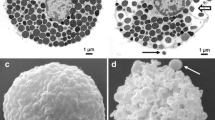Summary
The modifications of mouse mast cells incubated in solutions of polylysine at two different concentrations are studied. At higher dose (0.5 mg/ml), the polycation has evident toxic effects. At lower dose (0.5 μg/ml), it induces some modifications of the granule morphology. Cytochemical reactions to demonstrate polyanions, basic proteins and organic bases are used to study the granule content. A polylysine treatment promotes the release of basic groups (vaso-amines) and sulphydryl-containing compounds (basic protein) from the mast cell granules. On the contrary, polyanions remain in the cells and correspond to the granule matrix persisting after amino-liberator treatment.
Similar content being viewed by others
References
Baeckeland E (1969) Contribution à l'étude des caractères cytologiques et biologiques des mastocytes normaux du rat. Thèse d'Agrégation de l'Enseignement Supérieur. Université de Liège
Burwen SJ, Satir BM (1977) Plasma membrane folds on the mast cell surface and their relationship to secretory activity. J Cell Biol 74:690–697
Courtoy R, Simar LJ (1974) Importance of controls for the demonstration of carbohydrates in electron microscopy with the silver methenamine or the thiocarbohydrazide silver proteinate methods. J Microsc 100:199–211
Courtoy R, Boniver J, Simar LJ (1974) A cetylpyridinium chloride and ferric thiocyanate method for polyanions demonstration on thin sections for electron microscopy. Histochemistry 42:133–139
Courtoy R, Boniver J, Simar LJ (1976) Cytochemical demonstration of organic bases in mouse mast cells. In: Proceedings of the Electron Microscopy 6th European Congress, Jerusalem, TAL INTERNATIONAL publishing comp. Israël pp 178–179
Courtoy R, Boniver J, Simar LJ (1978) Cobalt thiocyanate as a stain for basic proteins and other organic bases on thin sections. Histochemistry 55:107–115
Ganter P, Jolles G (1969) Histochimie normale et pathologique. Gauthier Villars, Paris
Gomperts BD (1976) Calcium and cell activation. In Cuatrecasas E, Reaves G (eds) Receptor and recognition, Series A, 2 Chapman and Hall, London, pp 45–102
Jansson SE, Penttila H (1969) Effect of pH temperature, osmolarity and drugs on 5-hydroxytriptamine content and light and electron microscopic structure of rat mast cells in vitro. Exp Cell Res 54:367–376
Kessler S, Kuhn C (1975) Scanning electron microscopy of mast cell degranulation. Lab Invest 32:71–77
Kornguth SE, Stahmann MA, Anderson JW (1961) Effect of polylysine on the cytology of Ehrlich ascites tumor cells. Exp Cell Res 24:484–494
Lagunoff D, Phillips MT, Iseri OA, Benditt EP (1964) Isolation and preliminary characterization of rat mast cell granules. Lab Invest 13:1331–1344
Lagunoff D (1973) Membrane fusion during mast cell secretion. J Cell Biol 57:252–259
Padawer J (1970) The reaction of rat mast cells to polylysine. J Cell Biol 47:352–372
Röhrich P, Anderson P, Uvnas B (1971) Electron microscope observations on compound 48/80 induced degranulation in rat mast cells. J Cell Biol 51:465–483
Satch PS, Constantopoulos A, Nishioka K, Jajjar VA (1972) Tuftsin, thyreonyl-lysyl-prolyl-arginine the phagocytosis stimulating messenger of the currier cytophilic-α-globulin leucokinin. In Chemistry and biology of peptides. Ann Arbor Science Publishers, Ann Arbor MI, pp 403–408
Seljelid R, Silverstein SC, Cohn ZA (1973) The effect of poly-l-lysine on the uptake of reavirus double-stranded RNA in macrophages in vitro. J Cell Biol 57:484–498
Scott JE (1960) Aliphatic ammonium salts in the assay of acidic polysaccharides from tissues. In Glick D (ed) Methods of biochemical analysis, Vol. VIII. Intersciences Publishers, New York, pp 145–197
Uvnas B (1974) Histamine storage and release. Fed Proc 33:2172–2176
Author information
Authors and Affiliations
Rights and permissions
About this article
Cite this article
Courtoy, R., Boniver, J. & Simar, L.J. Cytochemistry of mouse mast cell reaction to polylysine. Histochemistry 66, 49–58 (1980). https://doi.org/10.1007/BF00493245
Accepted:
Issue Date:
DOI: https://doi.org/10.1007/BF00493245




